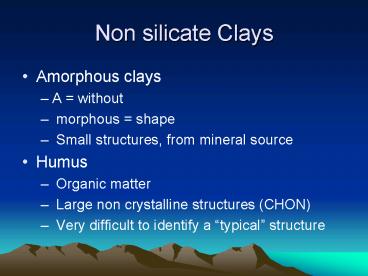Non silicate Clays - PowerPoint PPT Presentation
1 / 21
Title:
Non silicate Clays
Description:
Amount of substance it takes to combine with a mole of H ion. ... Valence= # of equivalents in one mole of a given ion. Equiv-w = g/mol /equiv/mol = g/equiv ... – PowerPoint PPT presentation
Number of Views:189
Avg rating:3.0/5.0
Title: Non silicate Clays
1
Non silicate Clays
- Amorphous clays
- A without
- morphous shape
- Small structures, from mineral source
- Humus
- Organic matter
- Large non crystalline structures (CHON)
- Very difficult to identify a typical structure
2
Non Silicate Colloids
- Modified crystalline structures, and they
commonly have neither tetrahedral nor octahedral
sheets in their composition. - Very little isomorphous subst.
- Charges from either removal or addition of H
ions to the surface of the oxy-hydroxyl groups.
3
Typical Non Silicate Amorphous Clays
- Iron and Aluminum Oxides
- Gibbsite Al(OH)3 Oxisols and Ultisols
- Goethite (FeOOH) yellow brown soils
- Hematite (Fe2O3) red soils
- Allophane and Imogolite Volcanic
- Si(OH)x and Al(OH)x
- In many soils clay silicates are mixed with non
silicates clays. They may form external coating,
and may alter typical behavior of clays.
4
Typical Non Silicate Humus Clays
- Humic substances
- Humus Humic acid, Fulvic acid, and Humin
- Humus includes sugar amines, nucleic acids,
phospholipids, vitamins, polysaccharides and many
other unclassified compounds - Very complex series of carbon chains and ring
structures - Numerous active functional groups (-COO-, NH2 )
- Very large specific surface area and charges
5
HUMUS
- CEC 300-700 meq/100 g soilcmol kg-1 soil
- Nutrients
- Capacity to chelate metals
- Nutrients and toxicity
- Very large specific surface area
- Increase water holding capacity
- Soil aggregation
- Source of N,S,P
6
Humus is part of the soil
- In most soils, humus substances are mixed with
silicates clays. They may form external coating,
and will alter typical behavior of clays. - Sometimes overwhelming the typical response.
7
Clay mineral-Clay humus
8
Review from last class
- Non silicate colloids
- Non crystalline structures
- Amorphous
- Mineral and organic
- Mineral
- Al/Fe oxides - implications
- Allophane and Imogolite - implications
- Humus
- Fulvic, Humic, Humin
- Very complex
- Functional groups
- Implications
9
Geographic distribution of Mineral Clays
- Midwest
- Prairie land MONTMORILLONITE, ILLITE, SMECTITES
- Southeast
- Subtropical- tropical KEOLINITE, Amorphous
mineral clays Fe/Al oxides
10
Genesis and Geographic of mineral clays
- Weathering
- Physical and chemical alteration
- Chemical decomposition-recrystallization
- Alteration Changes of particle size, and broken
edges. Weathered 21 - Recrystallization Complete breakdown of clay
structures and re-crystallization of a new
structure. 11 from 21
11
How ions interact with colloids
- Cations (POSITIVE CHARGES)
- Anions (NEGATIVE CHARGES)
- Implications?
12
Cations
- Positive charge
- Attract and attract to positive
- charge on colloids
- Most common ions
- K, Mg2, Ca2, NH4, Al3, H
- Cation exchange capacity CEC
- Sum of total cations that a given soil can
absorb - How this exchange works out?
13
Anions
- Negative charges
- Attracted to the positive charge on colloids
- Most common anions
- NO3-, HCO3-, OH-, SO4-
- Anion exchange capacity AEC
- Sum of total anions that a given soil can
absorb
14
Exchange Reactions
- Principles governing this phenomena
- Reversibility
- Ratio Law
- Cation selectivity
- Al 3 gt Ca 2 gt Mg 2 gt K NH4 gt Na
15
CEC
- Units Number of moles / equivalent of
charges absorbed per unit of mass. - meq/100 g soil
- cmol/kg soil (METRIC)
- WE WILL NOT USE THIS UNIT IN THIS CLASS.
- meq/100 g soil cmol/kg soil
- Nutrient availability in the soil system.
- Before going into CEC
- We need to understand the chemical definition of
meq!
16
meq?
- Chemical Unit Is the amount of ion required to
cancel out the electrical charge of an opposite
charged ion. - Amount of substance it takes to combine with a
mole of H ion. - EQUIVALENT, in chemistry, the proportion of an
element which will combine with or replace unit
weight of hydrogen. When multiplied by the
valency it gives the atomic weight. - Equiv gram-atomic weight/valence
- Valence of equivalents in one mole of a given
ion - Equiv-w g/mol /equiv/mol g/equiv
- meq Equiv/1000
17
meq?
- Equiv-w g-atomic Wt/valence
- Valence of equiv in one mole
- of a given ion
- Equiv-w g/mol /equiv/mol
- g/equiv
- if meq equiv/1000
- And mg g/1000
- Equiv-g meq-mg
18
Example
- How many equivalent-w are needed to neutralized
hydrogen? - MW 1 g/mol
- Valence 1 equiv/mol
- Ca equv 1 g/mol / 1 equiv/mol
- Ca equiv 1 g/equiv
- 1 mg/meq
19
Example
- How many equivalent-w are needed to neutralized
Calcium? - MW 40 g/mol
- Valence 2 equiv/mol
- Ca equv 40 g/mol / 2 equiv/mol
- Ca equiv 20 g/Equiv
- 20 mg/meq
20
Example
- How many equivalent-w are needed to neutralized
Aluminum? - MW 27 g/mol
- Valence 3 equiv/mol
- Ca equv 27 g/mol / 3 equiv/mol
- Ca equiv 9 g/Equiv
- 9 mg/meq
21
Example
- How many equivalent-w are needed to neutralized
ammonium? - MW 18 g/mol
- Valence 1 equiv/mol
- Ca equv 18 g/mol / 1 equiv/mol
- Ca equiv 18 g/Equiv
- 18 mg/meq

